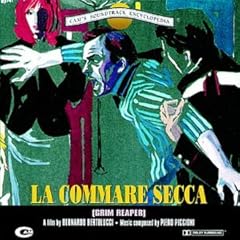
Let's get the most disgusting thing out of the way: Bertolucci made this film when he was 21 years old. I prefer to wallow in my own inadequacy right off the bat. Pasolini wrote it and helped land Bertolucci the job but it's an impressive start regardless (at least he looks older in a turtleneck).

La Commare Secca opens with a great joke—the first man to be interrogated for the murder of a prostitute that drives the narrative says that on the morning in question he went to go get a letter of recommendation from a priest. We immediately see him greeted by a hoodlum friend who calls, “You’re late, you bastard!” And so begins the parade of remarkably unlikable usual suspects. This petty thief is joined by a platinum blond pimp, a soldier who spends his leave stalking women, two sexed-crazed boys, a dead-eyed, park-cruising homosexual and, most crucially, a smooth-talking drifter who always wears clogs (the click clack sound is wonderful because it is at once as spritely as Fred Astaire's tap shoes and as menacing as Robert Ryan's leg dragging in Act of Violence).

With the narrative resting on the testimonies of these lowlifes, it’s surprising to realize this is one the most beautiful films ever made. Rome is revealed brilliantly —Bertolucci moves seamlessly from the low grey slums to the Coliseum, trash-choked river causeways to tinkling park fountain statuary. The camera paces left and right, zooms in and out, as restless as in the best of Altman, perambulating around the park where the murder takes place. It’s as if Antonioni had sustained the momentum of his coda for L’Eclisse for the entire picture (there’s also the hint of Blow Up as the events in the park are rewound from every possible angle).
While Bertolucci claimed never to have seen Rashomon before making his debut, it's hard to see one without being reminded of the other. I would argue that La Commare Secca is the more successful movie because it is calmer than Kurosawa's stimulating but hysterically-acted investigation of unreliable memory.
The different witness testimonies in La Commare Secca are nicely timestamped by a recurrent passing rain shower. The most spectacular sequence features the unsettling, staring soldier taking shelter in a tunnel that we find, through a long backwards tracking shot, is filled with prostitutes. We can’t see the soldier’s sickly grin but we know it’s still there. During these interludes the camera returns to the rain on the window of the ill-fated prostitute. Each time we see a bit more of her mundane afternoon activities before she goes out to meet her appointment in the evening. We become very attentive to her surroundings—for instance, her wallpaper is in a kitschy pattern Almódovar might enjoy. There is an odd elegance to her movements (like combing her hair or moving a coffee pot) that combine with the plaintive film score to make her a sympathetic figure, even though she never speaks a word.

If nothing else, La Commare Secca shows that films with inventively overlapping storylines were being made well before Tarantino's "revolution." I have to wonder what happened to all that inventiveness in Bertolucci's 2003 film, The Dreamers, which manages to be quite boring despite the impressive anatomies of Louis Garrel and Eva Green. The only redeeming part of that film is the quotes from classic cinema sprinkled throughout--we could easily see a shot from La Commare Secca, perhaps the young boys out with their dates, lounging on the walls above a breathtaking Roman vista--but that would only make us more wistful.


No comments:
Post a Comment